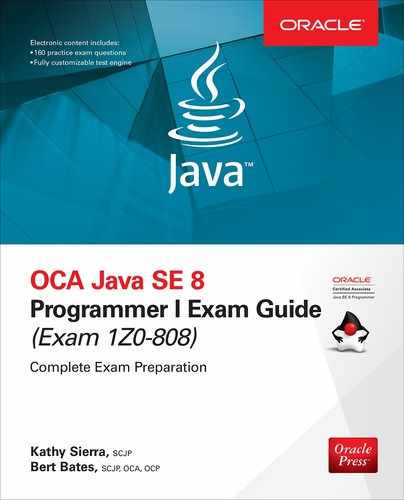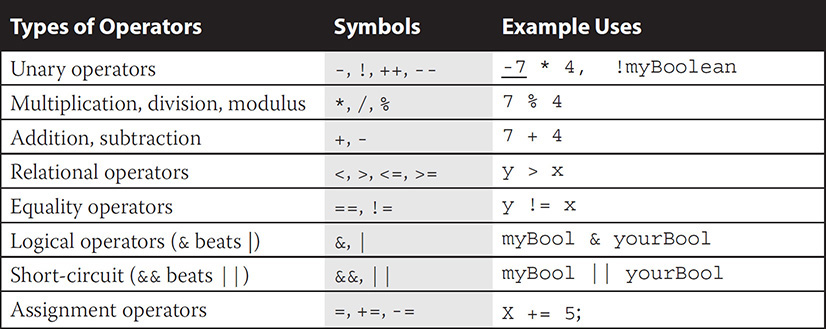
4
Operators
CERTIFICATION OBJECTIVES
• Using Java Operators
• Use Parentheses to Override Operator Precedence
• Test Equality Between Strings and Other Objects Using == and equals( )
![]() Two-Minute Drill
Two-Minute Drill
Q&A Self Test
If you’ve got variables, you’re going to modify them. (Unless you’re one of those new-fangled “FP” programmers.) You’ll increment them, add them together, and compare one to another (in about a dozen different ways). In this chapter, you’ll learn how to do all that in Java. As an added bonus, you’ll learn how to do things that you’ll probably never use in the real world, but that will almost certainly be on the exam.
CERTIFICATION OBJECTIVE
Java Operators (OCA Objectives 3.1, 3.2, and 3.3)
3.1 Use Java operators; including parentheses to override operator precedence.
3.2 Test equality between Strings and other objects using == and equals().
3.3 Create if and if/else and ternary constructs
Java operators produce new values from one or more operands. (Just so we’re all clear, remember that operands are the things on the right or left side of the operator.) The result of most operations is either a boolean or numeric value. Because you know by now that Java is not C++, you won’t be surprised that Java operators aren’t typically overloaded. There are, however, a few exceptional operators that come overloaded:
![]() The
The + operator can be used to add two numeric primitives together or to perform a concatenation operation if either operand is a String.
![]() The
The &, |, and ^ operators can all be used in two different ways, although on this version of the exam, their bit-twiddling capabilities won’t be tested.
Stay awake. Operators are often the section of the exam where candidates see their lowest scores. Additionally, operators and assignments are a part of many questions dealing with other topics—it would be a shame to nail a really tricky lambdas question only to blow it on a pre-increment statement.
Assignment Operators
We covered most of the functionality of the equal (=) assignment operator in Chapter 3. To summarize:
![]() When assigning a value to a primitive, size matters. Be sure you know when implicit casting will occur, when explicit casting is necessary, and when truncation might occur.
When assigning a value to a primitive, size matters. Be sure you know when implicit casting will occur, when explicit casting is necessary, and when truncation might occur.
![]() Remember that a reference variable isn’t an object; it’s a way to get to an object. (We know all you C++ programmers are just dying for us to say, “it’s a pointer,” but we’re not going to.)
Remember that a reference variable isn’t an object; it’s a way to get to an object. (We know all you C++ programmers are just dying for us to say, “it’s a pointer,” but we’re not going to.)
![]() When assigning a value to a reference variable, type matters. Remember the rules for supertypes, subtypes, and arrays.
When assigning a value to a reference variable, type matters. Remember the rules for supertypes, subtypes, and arrays.
Next we’ll cover a few more details about the assignment operators that are on the exam, and when we get to the next chapter, we’ll take a look at how the assignment operator = works with Strings (which are immutable).

![]() Bit-shifting operators
Bit-shifting operators
![]() Bitwise operators
Bitwise operators
![]() Two’s complement
Two’s complement
![]() Divide-by-zero stuff
Divide-by-zero stuff
Compound Assignment Operators
There are actually 11 or so compound assignment operators, but only the 4 most commonly used (+=, -=, *=, and /=) are on the exam. The compound assignment operators let lazy typists shave a few keystrokes off their workload.
Here are several example assignments, first without using a compound operator:
y = y - 6;
x = x + 2 * 5;
Now, with compound operators:
y -= 6;
x += 2 * 5;
The last two assignments give the same result as the first two.
Relational Operators
The exam covers six relational operators (<, <=, >, >=, ==, and !=). Relational operators always result in a boolean (true or false) value. This boolean value is most often used in an if test, as follows:

But the resulting value can also be assigned directly to a boolean primitive:

Java has four relational operators that can be used to compare any combination of integers, floating-point numbers, or characters:
![]()
> Greater than
![]()
>= Greater than or equal to
![]()
<= Less than or equal to
Let’s look at some legal comparisons:
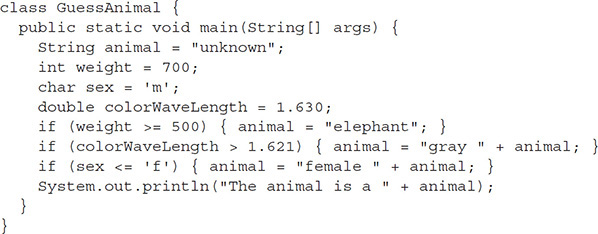
In the preceding code, we are using a comparison between characters. It’s also legal to compare a character primitive with any number (although it isn’t great programming style). Running the preceding class will output the following:
The animal is a gray elephant
We mentioned that characters can be used in comparison operators. When comparing a character with a character or a character with a number, Java will use the Unicode value of the character as the numerical value for comparison.
“Equality” Operators
Java also has two relational operators (sometimes called “equality operators”) that compare two similar “things” and return a boolean (true or false) that represents what’s true about the two “things” being equal. These operators are
![]()
== Equal (also known as equal to)
![]()
!= Not equal (also known as not equal to)
Each individual comparison can involve two numbers (including char), two boolean values, or two object reference variables. You can’t compare incompatible types, however. What would it mean to ask if a boolean is equal to a char? Or if a Button is equal to a String array? (This is nonsense, which is why you can’t do it.) There are four different types of things that can be tested:
![]() Numbers
Numbers
![]() Characters
Characters
![]() Boolean primitives
Boolean primitives
![]() Object reference variables
Object reference variables
So what does == look at? The value in the variable—in other words, the bit pattern.
Equality for Primitives
Most programmers are familiar with comparing primitive values. The following code shows some equality tests on primitive variables:

This program produces the following output:

As you can see, if a floating-point number is compared with an integer and the values are the same, the == operator usually returns true as expected.
Equality for Reference Variables
As you saw earlier, two reference variables can refer to the same object, as the following code snippet demonstrates:
![]()
After running this code, both variable a and variable b will refer to the same object (a JButton with the label Exit). Reference variables can be tested to see if they refer to the same object by using the == operator. Remember, the == operator is looking at the bits in the variable, so for reference variables, this means that if the bits in both reference variables are identical, then both refer to the same object. Look at the following code:

This code creates three reference variables. The first two, a and b, are separate JButton objects that happen to have the same label. The third reference variable, c, is initialized to refer to the same object that a refers to. When this program runs, the following output is produced:
![]()
This shows us that a and c reference the same instance of a JButton. The == operator will not test whether two objects are “meaningfully equivalent,” a concept we’ll cover in much more detail in Chapter 6, when we look at the equals() method (as opposed to the equals operator we’re looking at here).
Equality for Strings and java.lang.Object.equals()
We just used == to determine whether two reference variables refer to the same object. Because objects are so central to Java, every class in Java inherits a method from class Object that tests to see if two objects of the class are “equal.” Not surprisingly, this method is called equals(). In this case of the equals() method, the phrase “meaningfully equivalent” should be used instead of the word “equal.” So the equals() method is used to determine if two objects of the same class are “meaningfully equivalent.” For classes that you create, you have the option of overriding the equals() method that your class inherited from class Object and creating your own definition of “meaningfully equivalent” for instances of your class.
In terms of understanding the equals() method for the OCA exam, you need to understand two aspects of the equals() method:
![]() What
What equals() means in class Object
![]() What
What equals() means in class String
The equals() Method in Class Object The equals() method in class Object works the same way that the == operator works. If two references point to the same object, the equals() method will return true. If two references point to different objects, even if they have the same values, the method will return false.
The equals() Method in Class String The equals() method in class String has been overridden. When the equals() method is used to compare two strings, it will return true if the strings have the same value, and it will return false if the strings have different values. For String’s equals() method, values ARE case sensitive.
Let’s take a look at how the equals() method works in action (notice that the Budgie class did NOT override Object.equals()):

which produces the output:
false
true
true
false
Equality for enums
Once you’ve declared an enum, it’s not expandable. At runtime, there’s no way to make additional enum constants. Of course, you can have as many variables as you’d like refer to a given enum constant, so it’s important to be able to compare two enum reference variables to see if they’re “equal”—that is, do they refer to the same enum constant? You can use either the == operator or the equals() method to determine whether two variables are referring to the same enum constant:

(We know } } is ugly; we’re prepping you.) This produces the output:
![]()
instanceof Comparison
The instanceof operator is used for object reference variables only, and you can use it to check whether an object is of a particular type. By “type,” we mean class or interface type—in other words, whether the object referred to by the variable on the left side of the operator passes the IS-A test for the class or interface type on the right side. (Chapter 2 covered IS-A relationships in detail.) The following simple example,

prints this:
s is a String
Even if the object being tested is not an actual instantiation of the class type on the right side of the operator, instanceof will still return true if the object being compared is assignment compatible with the type on the right.
The following example demonstrates a common use for instanceof: testing an object to see if it’s an instance of one of its subtypes before attempting a downcast:
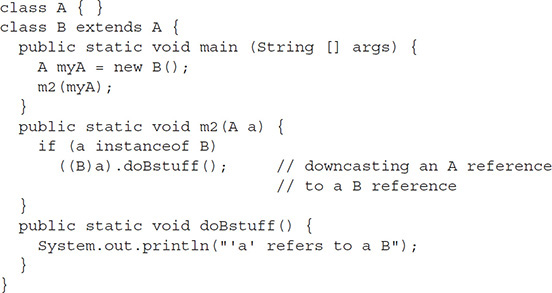
The code compiles and produces this output:
‘a’ refers to a B
In examples like this, the use of the instanceof operator protects the program from attempting an illegal downcast.
You can test an object reference against its own class type or any of its superclasses. This means that any object reference will evaluate to true if you use the instanceof operator against type Object, as follows:

This prints
b is definitely an Object



In addition, it is legal to test whether the null reference is an instance of a class. This will always result in false, of course. This example,

prints this:
false false
instanceof Compiler Error
You can’t use the instanceof operator to test across two different class hierarchies. For instance, the following will NOT compile:

Compilation fails—there’s no way d could ever refer to a Cat or a subtype of Cat.

![]()
Table 4-1 summarizes the use of the instanceof operator given the following:
TABLE 4-1 Operands and Results Using instanceof Operator

Arithmetic Operators
We’re sure you’re familiar with the basic arithmetic operators:
![]() + addition
+ addition
![]() – subtraction
– subtraction
![]() * multiplication
* multiplication
![]() / division
/ division
These can be used in the standard way:

The Remainder (%) Operator (a.k.a. the Modulus Operator)
One operator you might not be as familiar with is the remainder operator: %. The remainder operator divides the left operand by the right operand, and the result is the remainder, as the following code demonstrates:

Running class MathTest prints the following:
The result of 15 % 4 is the remainder of 15 divided by 4. The remainder is 3
(Remember: Expressions are evaluated from left to right by default. You can change this sequence, or precedence, by adding parentheses. Also remember that the *, /, and % operators have a higher precedence than the + and - operators.)
![]() The modulus operator throws out
The modulus operator throws out everything but the remainder.
![]() The division operator throws out the remainder.
The division operator throws out the remainder.
String Concatenation Operator
The plus sign can also be used to concatenate two strings together, as we saw earlier (and as we’ll definitely see again):
![]()
String concatenation gets interesting when you combine numbers with Strings. Check out the following:

Will the + operator act as a plus sign when adding the int variables b and c? Or will the + operator treat 3 and 7 as characters and concatenate them individually? Will the result be String10 or String37? Okay, you’ve had long enough to think about it.
The int values were simply treated as characters and glued on to the right side of the String, giving the result:
String37
So we could read the previous code as
“Start with the value String, and concatenate the character 3 (the value of b) to it, to produce a new string String3, and then concatenate the character 7 (the value of c) to that, to produce a new string String37. Then print it out.”
However, if you put parentheses around the two int variables, as follows,
System.out.println(a + (b + c));
you’ll get this:
String10
Using parentheses causes the (b + c) to evaluate first, so the rightmost + operator functions as the addition operator, given that both operands are int values. The key point here is that within the parentheses, the left-hand operand is not a String. If it were, then the + operator would perform String concatenation. The previous code can be read as
“Add the values of b and c together, and then take the sum and convert it to a String and concatenate it with the String from variable a.”
The rule to remember is this:
If either operand is a String, the + operator becomes a String concatenation operator. If both operands are numbers, the + operator is the addition operator.
You’ll find that sometimes you might have trouble deciding whether, say, the left-hand operator is a String or not. On the exam, don’t expect it always to be obvious. (Actually, now that we think about it, don’t expect it ever to be obvious.) Look at the following code:
System.out.println(x.foo() + 7);
You can’t know how the + operator is being used until you find out what the foo() method returns! If foo() returns a String, then 7 is concatenated to the returned String. But if foo() returns a number, then the + operator is used to add 7 to the return value of foo().
Finally, you need to know that it’s legal to mush together the compound additive operator (+=) and Strings, like so:

Since both times the += operator was used and the left operand was a String, both operations were concatenations, resulting in
1234567
Increment and Decrement Operators
Java has two operators that will increment or decrement a variable by exactly one. These operators are either two plus signs (++) or two minus signs (--):
![]() ++ Increment (prefix and postfix)
++ Increment (prefix and postfix)
![]() -- Decrement (prefix and postfix)
-- Decrement (prefix and postfix)
The operator is placed either before (prefix) or after (postfix) a variable to change its value. Whether the operator comes before or after the operand can change the outcome of an expression. Examine the following:
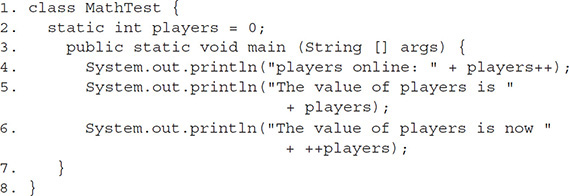
Notice that in the fourth line of the program the increment operator is after the variable players. That means we’re using the postfix increment operator, which causes players to be incremented by one but only after the value of players is used in the expression. When we run this program, it outputs the following:

Notice that when the variable is written to the screen, at first it says the value is 0. Because we used the postfix increment operator, the increment doesn’t happen until after the players variable is used in the print statement. Get it? The “post” in postfix means after. Line 5 doesn’t increment players; it just outputs its value to the screen, so the newly incremented value displayed is 1. Line 6 applies the prefix increment operator to players, which means the increment happens before the value of the variable is used, so the output is 2.
Expect to see questions mixing the increment and decrement operators with other operators, as in the following example:

The preceding code prints this:
x = 3 y = 4
You can read the code as follows: “If 3 is equal to 2 OR 3 < 4”
The first expression compares x and y, and the result is false, because the increment on x doesn’t happen until after the == test is made. Next, we increment x, so now x is 3. Then we check to see if x is less than y, but we increment y before comparing it with x! So the second logical test is (3 < 4). The result is true, so the print statement runs.
As with String concatenation, the increment and decrement operators are used throughout the exam, even on questions that aren’t trying to test your knowledge of how those operators work. You might see them in questions on for loops, exceptions, or even threads. Be ready.
Conditional Operator
The conditional operator is a ternary operator (it has three operands) and is used to evaluate boolean expressions—much like an if statement, except instead of executing a block of code if the test is true, a conditional operator will assign a value to a variable. In other words, the goal of the conditional operator is to decide which of two values to assign to a variable. This operator is constructed using a ? (question mark) and a : (colon). The parentheses are optional. Here is its structure:
x = (boolean expression) ? value to assign if true : value to assign if false
Let’s take a look at a conditional operator in code:

You can read the preceding code as “Set numOfPets equal to 3“.
Next we’re going to assign a String to the status variable. If numOfPets is less than 4, assign “Pet limit not exceeded” to the status variable; otherwise, assign “too many pets” to the status variable.
A conditional operator starts with a boolean operation, followed by two possible values for the variable to the left of the assignment (=) operator. The first value (the one to the left of the colon) is assigned if the conditional (boolean) test is true, and the second value is assigned if the conditional test is false. You can even nest conditional operators into one statement:
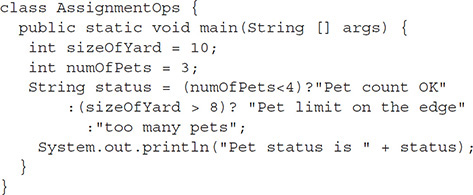
Don’t expect many questions using conditional operators, but you might get one.
Logical Operators
The exam objectives specify six “logical” operators (&, |, ^, !, &&, and ||). Some Oracle documentation uses other terminology for these operators, but for our purposes and in the exam objectives, these six are the logical operators.
Bitwise Operators (Not an Exam Topic!)
Okay, this is going to be confusing. Of the six logical operators just listed, three of them (&, |, and ^) can also be used as “bitwise” operators. Bitwise operators were included in previous versions of the exam, but they’re NOT on the Java 6, Java 7, or Java 8 exam. We bring them up here just so you have a more complete picture of the logical operators.
Here are several legal statements that use bitwise operators:

Bitwise operators compare two variables bit by bit and return a variable whose bits have been set based on whether the two variables being compared had respective bits that were either both “on” (&), one or the other “on” (|), or exactly one “on” (^). By the way, when we run the preceding code, we get
0 15 1

Short-Circuit Logical Operators
Five logical operators on the exam are used to evaluate statements that contain more than one boolean expression. The most commonly used of the five are the two short-circuit logical operators:
![]()
&& Short-circuit AND
![]()
|| Short-circuit OR
They are used to link little boolean expressions together to form bigger boolean expressions. The && and || operators evaluate only boolean values. For an AND (&&) expression to be true, both operands must be true. For example:
if ((2 < 3) && (3 < 4)) { }
The preceding expression evaluates to true because both operand one (2 < 3) and operand two (3 < 4) evaluate to true.
The short-circuit feature of the && operator is so named because it doesn’t waste its time on pointless evaluations. A short-circuit && evaluates the left side of the operation first (operand one), and if it resolves to false, the && operator doesn’t bother looking at the right side of the expression (operand two) since the && operator already knows that the complete expression can’t possibly be true.

When we run the preceding code, the assignment (b2 = true) never runs because of the short-circuit operator, so the output is
![]()
The || operator is similar to the && operator, except that it evaluates to true if EITHER of the operands is true. If the first operand in an OR operation is true, the result will be true, so the short-circuit || doesn’t waste time looking at the right side of the equation. If the first operand is false, however, the short-circuit || has to evaluate the second operand to see if the result of the OR operation will be true or false. Pay close attention to the following example; you’ll see quite a few questions like this on the exam:

What is the result?

Here’s what happened when the main() method ran:
1. When we hit line 3, the first operand in the || expression (in other words, the left side of the || operation) is evaluated.
2. The isItSmall(3) method is invoked, prints “i < 5”, and returns true.
3. Because the first operand in the || expression on line 3 is true, the || operator doesn’t bother evaluating the second operand. So we never see the “i >= 5” that would have printed had the second operand been evaluated (which would have invoked isItSmall(7)).
4. Line 6 is evaluated, beginning with the first operand in the || expression.
5. The isItSmall(6) method is called, prints “i >= 5”, and returns false.
6. Because the first operand in the || expression on line 6 is false, the || operator can’t skip the second operand; there’s still a chance the expression can be true, if the second operand evaluates to true.
7. The isItSmall(9) method is invoked and prints “i >= 5”.
8. The isItSmall(9) method returns false, so the expression on line 6 is false, and thus line 7 never executes.

if (5 && 6) { }
Logical Operators (not Short-Circuit)
There are two non-short-circuit logical operators:
![]()
& Non-short-circuit AND
![]()
| Non-short-circuit OR
These operators are used in logical expressions just like the && and || operators are used, but because they aren’t the short-circuit operators, they evaluate both sides of the expression—always! They’re inefficient. For example, even if the first operand (left side) in an & expression is false, the second operand will still be evaluated—even though it’s now impossible for the result to be true! And the | is just as inefficient: if the first operand is true, the Java Virtual Machine (JVM) still plows ahead and evaluates the second operand even when it knows the expression will be true regardless.
You’ll find a lot of questions on the exam that use both the short-circuit and non-short-circuit logical operators. You’ll have to know exactly which operands are evaluated and which are not, because the result will vary depending on whether the second operand in the expression is evaluated. Consider this,
![]()
versus this:
![]()
Logical Operators ^ and !
The last two logical operators on the exam are
![]()
^ Exclusive-OR (XOR)
![]()
! Boolean invert
The ^ (exclusive-OR) operator evaluates only boolean values. The ^ operator is related to the non-short-circuit operators we just reviewed, in that it always evaluates both the left and right operands in an expression. For an exclusive-OR (^) expression to be true, EXACTLY one operand must be true. This example,
System.out.println(“xor ” + ((2 < 3) ^ (4 > 3)));
produces this output:
xor false
The preceding expression evaluates to false because BOTH operand one (2 < 3) and operand two (4 > 3) evaluate to true.
The ! (boolean invert) operator returns the opposite of a boolean’s current value. The following statement,
if(!(7 == 5)) { System.out.println(“not equal”); }
can be read “If it’s not true that 7 == 5,” and the statement produces this output:
not equal
Here’s another example using booleans:

It produces this output:
! true false
In the preceding example, notice that the & test succeeded (printing true) and that the value of the boolean variable f did not change, so it printed false.
Operator Precedence
The OCA 8 exam has reintroduced the topic of operator precedence. As you probably already know but will definitely see demonstrated in this section, when several operators are used in combination, the order in which they are evaluated can alter the result of the expression.
Operator Precedence Rant
Allow us to rant for a minute here. Memorizing operator precedence was on the old SCJP 1.2 exam about 15 years ago. Starting with the SCJP 1.4 exam, and for all the exams until the OCA 8, operator precedence has not been on the exam. For a glorious 15 years, candidates didn’t have to do this bit of memorization. Sadly, this topic snuck its way back into the exam for OCA 8. Why do we care so much about this? Take a look at this code:
System.out.println(true & false == false | true);
What result would you expect? Imagine a more realistic version, evaluating some booleans:
System.out.println(b1 & b2 == b3 | b4);
What would you guess the programmer’s intention was here? There are two likely scenarios:
Scenario 1: (b1 & b2) == (b3 | b4) If this was the programmer’s intention, then he just created a bug.
Scenario 2: b1 & (b2 == b3) | b4 If this was the programmer’s intention, then the code will work as intended, but his boss and fellow workers will want to strangle him.
This is a long-winded way to say that when you’re writing code, you shouldn’t rely on everyone’s memory of operator precedence. You should just use parentheses like civilized people do.
The Actual Beginning of the Operator Precedence Section
Table 4-2 lists the most commonly used operators and their relative precedence, starting at the top with the highest precedence operators and ending at the bottom with the lowest. (Note, not all of Java’s operators are in this table!)
TABLE 4-2 Precedence Hierarchy of Common Operators (from Highest to Lowest)
JavaRanch (we know, we know, “Coderanch”) moderator Fritz Walraven shared this tip with us. We like it, and we’re passing it along to you: for the table above, you might make up a word like “UMARELSA,” or a sentence using those first letters, to help you remember the precedence rules!
There are three important general rules for determining how Java will evaluate expressions with operators:
![]() When two operators of the same precedence are in the same expression, Java evaluates the expression from left to right.
When two operators of the same precedence are in the same expression, Java evaluates the expression from left to right.
![]() When parts of an expression are placed in parentheses, those parts are evaluated first.
When parts of an expression are placed in parentheses, those parts are evaluated first.
![]() When parentheses are nested, the innermost parentheses are evaluated first.
When parentheses are nested, the innermost parentheses are evaluated first.
A good way to burn these precedence rules into your brain is to—as always—write some test code and play around with it. We’ve added an example of some test code that demonstrates several of the precedence hierarchy rules listed here. As you can see, we often compared parentheses-free expressions with their parentheses-rich counterparts to prove the rules:

And to repeat, the output is:

We’re so sorry that you need to memorize this stuff, but if you master what’s in this short section, you should be able to handle whatever weird precedence-related questions the exam throws at you.
CERTIFICATION SUMMARY
If you’ve studied this chapter diligently, you should have a firm grasp on Java operators, and you should understand what equality means when tested with the == operator. Let’s review the highlights of what you’ve learned in this chapter.
The logical operators (&&, ||, &, |, and ^) can be used only to evaluate two boolean expressions. The difference between && and & is that the && operator won’t bother testing the right operand if the left evaluates to false, because the result of the && expression can never be true. The difference between || and | is that the || operator won’t bother testing the right operand if the left evaluates to true because the result is already known to be true at that point.
The == operator can be used to compare values of primitives, but it can also be used to determine whether two reference variables refer to the same object.
The instanceof operator is used to determine whether the object referred to by a reference variable passes the IS-A test for a specified type.
The + operator is overloaded to perform String concatenation tasks and can also concatenate Strings and primitives, but be careful—concatenation can be tricky.
The conditional operator (a.k.a. the “ternary operator”) has an unusual, three-operand syntax—don’t mistake it for a complex assert statement.
The ++ and -- operators will be used throughout the exam, and you must pay attention to whether they are prefixed or postfixed to the variable being updated.
Even though you should use parentheses in real life, for the exam you should memorize Table 4-2 so you can determine how code that doesn’t use parentheses for complex expressions will be evaluated, based on Java’s operator-precedence hierarchy.
Be prepared for a lot of exam questions involving the topics from this chapter. Even within questions testing your knowledge of another objective, the code will frequently use operators, assignments, object and primitive passing, and so on.
 TWO-MINUTE DRILL
TWO-MINUTE DRILL
Here are some of the key points from each section in this chapter.
Relational Operators (OCA Objectives 3.1 and 3.2)
![]() Relational operators always result in a
Relational operators always result in a boolean value (true or false).
![]() There are six relational operators:
There are six relational operators: >, >=, <, <=, ==, and !=. The last two (== and !=) are sometimes referred to as equality operators.
![]() When comparing characters, Java uses the Unicode value of the character as the numerical value.
When comparing characters, Java uses the Unicode value of the character as the numerical value.
![]() Equality operators
Equality operators
![]() There are two equality operators:
There are two equality operators: == and !=.
![]() Four types of things can be tested: numbers, characters, booleans, and reference variables.
Four types of things can be tested: numbers, characters, booleans, and reference variables.
![]() When comparing reference variables,
When comparing reference variables, == returns true only if both references refer to the same object.
instanceof Operator (OCA Objective 3.1)
![]()
instanceof is for reference variables only; it checks whether the object is of a particular type.
![]() The
The instanceof operator can be used only to test objects (or null) against class types that are in the same class hierarchy.
![]() For interfaces, an object passes the
For interfaces, an object passes the instanceof test if any of its superclasses implement the interface on the right side of the instanceof operator.
Arithmetic Operators (OCA Objective 3.1)
![]() The four primary math operators are add (
The four primary math operators are add (+), subtract (–), multiply (*), and divide (/).
![]() The remainder (a.k.a. modulus) operator (
The remainder (a.k.a. modulus) operator (%) returns the remainder of a division.
![]() Expressions are evaluated from left to right, unless you add parentheses, or unless some operators in the expression have higher precedence than others.
Expressions are evaluated from left to right, unless you add parentheses, or unless some operators in the expression have higher precedence than others.
![]() The
The *, /, and % operators have higher precedence than + and –.
String Concatenation Operator (OCA Objective 3.1)
![]() If either operand is a
If either operand is a String, the + operator concatenates the operands.
![]() If both operands are numeric, the
If both operands are numeric, the + operator adds the operands.
Increment/Decrement Operators (OCA Objective 3.1)
![]() Prefix operators (e.g.
Prefix operators (e.g. --x) run before the value is used in the expression.
![]() Postfix operators (e.g.,
Postfix operators (e.g., x++) run after the value is used in the expression.
![]() In any expression, both operands are fully evaluated before the operator is applied.
In any expression, both operands are fully evaluated before the operator is applied.
![]() Variables marked
Variables marked final cannot be incremented or decremented.
Ternary (Conditional) Operator (OCA Objective 3.3)
![]() Returns one of two values based on the state of its
Returns one of two values based on the state of its boolean expression.
![]() Returns the value after the
Returns the value after the ? if the expression is true.
![]() Returns the value after the
Returns the value after the : if the expression is false.
Logical Operators (OCA Objective 3.1)
![]() The exam covers six “logical” operators:
The exam covers six “logical” operators: &, |, ^, !, &&, and ||.
![]() Work with two expressions (except for
Work with two expressions (except for !) that must resolve to boolean values.
![]() The
The && and & operators return true only if both operands are true.
![]() The
The || and | operators return true if either or both operands are true.
![]() The
The && and || operators are known as short-circuit operators.
![]() The
The && operator does not evaluate the right operand if the left operand is false.
![]() The
The || does not evaluate the right operand if the left operand is true.
![]() The
The & and | operators always evaluate both operands.
![]() The
The ^ operator (called the “logical XOR”) returns true if exactly one operand is true.
![]() The
The ! operator (called the “inversion” operator) returns the opposite value of the boolean operand it precedes.
Parentheses and Operator Precedence (OCA Objective 3.1)
![]() In real life, use parentheses to clarify your code, and force Java to evaluate expressions as intended.
In real life, use parentheses to clarify your code, and force Java to evaluate expressions as intended.
![]() For the exam, memorize Table 4-2 to determine how parentheses-free code will be evaluated.
For the exam, memorize Table 4-2 to determine how parentheses-free code will be evaluated.
SELF TEST
1. Given:

What is the result?
A. null
B. life
C. universe
D. everything
E. Compilation fails
F. An exception is thrown at runtime
2. Given:
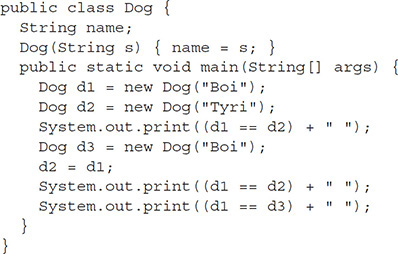
What is the result?
A. true true true
B. true true false
C. false true false
D. false true true
E. false false false
F. An exception will be thrown at runtime
3. Given:
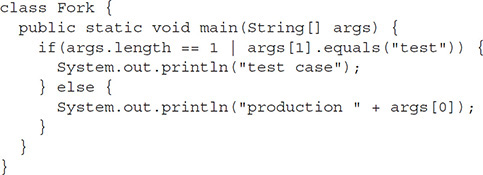
And the command-line invocation:
java Fork live2
What is the result?
A. test case
B. production live2
C. test case live2
D. Compilation fails
E. An exception is thrown at runtime
4. Given:
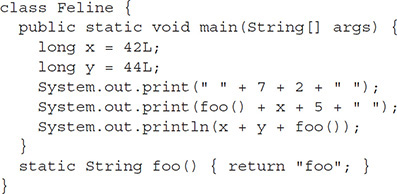
What is the result?
A. 9 foo47 86foo
B. 9 foo47 4244foo
C. 9 foo425 86foo
D. 9 foo425 4244foo
E. 72 foo47 86foo
G. 72 foo425 86foo
H. 72 foo425 4244foo
I. Compilation fails
5. Note: Here’s another old-style drag-and-drop question…just in case.
Place the fragments into the code to produce the output 33. Note that you must use each fragment exactly once.
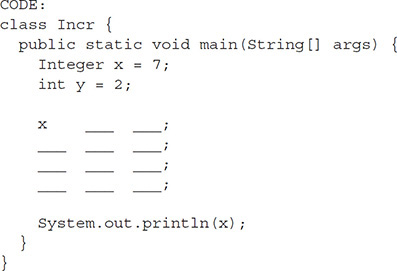
FRAGMENTS:

6. Given:

What is the result? (Choose all that apply.)
A. 2 1
B. 2 2
C. 3 1
D. 3 2
E. An exception is thrown at runtime
7. Given:
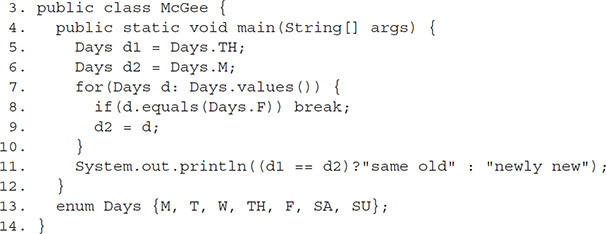
What is the result?
A. same old
B. newly new
C. Compilation fails due to multiple errors
D. Compilation fails due only to an error on line 7
E. Compilation fails due only to an error on line 8
F. Compilation fails due only to an error on line 11
G. Compilation fails due only to an error on line 13
8. Given:

Which are true? (Choose all that apply.)
A. Compilation fails
B. x will be included in the output
C. y will be included in the output
D. z will be included in the output
E. An exception is thrown at runtime
9. Given:

Which two are true about the value of mask and the value of count at line 10? (Choose two.)
A. mask is 0
B. mask is 1
C. mask is 2
D. mask is 10
E. mask is greater than 10
F. count is 0
G. count is greater than 0
10. Given:

What is the result?
A. 0
B. 01
C. 02
D. 012
E. Compilation fails
F. An exception is thrown at runtime
11. Given:

What is the result? (This is a tricky one. If you want a hint, go take another look at the operator precedence rant in the chapter.)
A. true true
B. false true
C. true false
D. false false
E. Compilation fails
F. An exception is thrown at runtime
SELF TEST ANSWERS
1. ![]() D is correct. This is a ternary nested in a ternary. Both ternary expressions are false.
D is correct. This is a ternary nested in a ternary. Both ternary expressions are false.![]() A, B, C, E, and F are incorrect based on the above. (OCA Objective 3.1 and 3.3)
A, B, C, E, and F are incorrect based on the above. (OCA Objective 3.1 and 3.3)
2. ![]() C is correct. The
C is correct. The == operator tests for reference variable equality, not object equality.![]() A, B, D, E, and F are incorrect based on the above. (OCA Objectives 3.1 and 3.2)
A, B, D, E, and F are incorrect based on the above. (OCA Objectives 3.1 and 3.2)
3. ![]() E is correct. Because the short-circuit (
E is correct. Because the short-circuit (||) is not used, both operands are evaluated. Since args[1] is past the args array bounds, an ArrayIndexOutOfBoundsException is thrown.![]() A, B, C, and D are incorrect based on the above. (OCA Objectives 3.1 and 3.2)
A, B, C, and D are incorrect based on the above. (OCA Objectives 3.1 and 3.2)
4. ![]() G is correct. Concatenation runs from left to right, and if either operand is a
G is correct. Concatenation runs from left to right, and if either operand is a String, the operands are concatenated. If both operands are numbers, they are added together.![]() A, B, C, D, E, F, H, and I are incorrect based on the above. (OCA Objective 3.1)
A, B, C, D, E, F, H, and I are incorrect based on the above. (OCA Objective 3.1)
5. Answer:
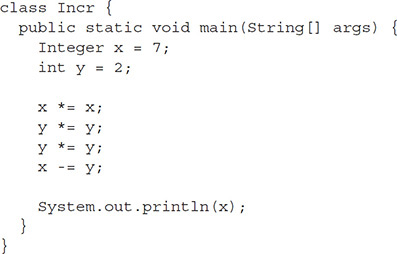
Yeah, we know it’s kind of puzzle-y, but you might encounter something like it on the real exam if Oracle reinstates this type of question. (OCA Objective 3.1)
6. ![]() A is correct. When dividing
A is correct. When dividing ints, remainders are always rounded down.![]() B, C, D, and E are incorrect based on the above. (OCA Objective 3.1)
B, C, D, and E are incorrect based on the above. (OCA Objective 3.1)
7. ![]() A is correct. All this syntax is correct. The for-each iterates through the
A is correct. All this syntax is correct. The for-each iterates through the enum using the values() method to return an array. An enum can be compared using either equals() or ==. An enum can be used in a ternary operator’s boolean test.![]() B, C, D, E, F, and G are incorrect based on the above. (OCA Objectives 3.1, 3.2, and 3.3)
B, C, D, E, F, and G are incorrect based on the above. (OCA Objectives 3.1, 3.2, and 3.3)
8. ![]() C is correct. Line 9 uses the modulus operator, which returns the remainder of the division, which in this case is
C is correct. Line 9 uses the modulus operator, which returns the remainder of the division, which in this case is 1. Also, line 9 sets b2 to false, and it doesn’t test b2’s value. Line 10 would set b2 to true; however, the short-circuit operator keeps the expression b2 = true from being executed.![]() A, B, D, and E are incorrect based on the above. (OCA Objectives 3.1, and 3.2)
A, B, D, and E are incorrect based on the above. (OCA Objectives 3.1, and 3.2)
9. ![]() C and F are correct. At line 7 the
C and F are correct. At line 7 the || keeps count from being incremented, but the | allows mask to be incremented. At line 8 the ^ returns true only if exactly one operand is true. At line 9 mask is 2 and the && keeps count from being incremented.![]() A, B, D, E, and G are incorrect based on the above. (OCA Objective 3.1)
A, B, D, E, and G are incorrect based on the above. (OCA Objective 3.1)
10. ![]() D is correct. First, remember that
D is correct. First, remember that instanceof can look up through multiple levels of an inheritance tree. Also remember that instanceof is commonly used before attempting a downcast; so in this case, after line 15, it would be possible to say Speedboat s3 = (Speedboat)b2;.![]() A, B, C, E, and F are incorrect based on the above. (OCA Objective 3.1)
A, B, C, E, and F are incorrect based on the above. (OCA Objective 3.1)
11. ![]() A is correct. We’re pretty sure you won’t encounter anything as horrible as this on the real exam. But if you got this one correct, pat yourself on the back! The way to tackle a problem like this is to evaluate the expression in stages. In this case you might solve it like so:
A is correct. We’re pretty sure you won’t encounter anything as horrible as this on the real exam. But if you got this one correct, pat yourself on the back! The way to tackle a problem like this is to evaluate the expression in stages. In this case you might solve it like so:
Stage 1: resolve any use of unary operators
Stage 2: resolve any use of multiplication-related operators
Stage 3: handle addition and subtraction
Stage 4: handle any relationship operators
Stage 5: deal with the equality operators
Stage 6: deal with the logical operators
Stage 7: do the short-circuit operators
Stage 8: finally, do the assignment operators
![]() B, C, D, E, and F are incorrect based on the above. (OCA Objective 3.1)
B, C, D, E, and F are incorrect based on the above. (OCA Objective 3.1)
